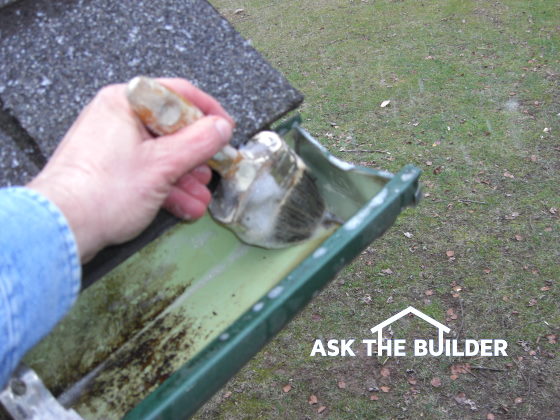Gutter Repair

An old paint brush is a great tool to clean the tight inside corners of a gutter. Use lots of soapy water. PHOTO CREDIT: Tim Carter
DEAR TIM: The one-story home I just purchased needs some gutter repair. When it rains, I see leaks at the ends of my aluminum gutters. I also see water streaming from behind my gutters on the facia board.
In addition, I need to make a gutter downspout repair where a downspout has fallen away to the ground. What special tools might I need, and what tips can you share to make this just an afternoon job, instead of a weekend nightmare? Steve F., White Plains, NY
DEAR STEVE: I’d probably tell you to hire a professional for this job had you not told me the gutters are close to the ground. Working up in the air from ladders can be dangerous indeed, and if you’re not experienced, all sorts of bad jujumagumbo can happen. I know of a young widow who lost her husband as he worked on a ladder that was leaning against a second-story roof overhang.
Roof gutter repair is not technically difficult, especially if you’re just trying to seal some seams where the sealant has failed. The job is also easy because you’re working with aluminum. Galvanized steel and copper gutter repair are usually not do-it-yourself jobs, as the seams in these materials almost always are soldered. You’ll be using a special sealant that works like toothpaste on your aluminum gutters. The biggest difference is I don’t want you to get any of the sealant in your mouth.
Aluminum gutter repair starts with clean, dry metal. The odds are the inside of your gutters are dirty and have a layer of muck in them. You need to do whatever is necessary to make the inside of the gutters perfectly clean wherever you intend to perform sealant repairs.
One of the best tools I’ve used for years is an old 3-inch paint brush. After removing all of the debris from the gutter, I dip the brush in some warm soapy water and begin dabbing and sloshing the water in all the tight spaces. The dirt and organic debris usually wash away quickly and with minimal effort. Work until all the dirt is gone, and rinse well with clear water.
If the gutter drains well, the sun is out and you have a breeze, the joint at the end cap and the gutter can be dry in as little as 30 minutes. Use a paper towel to check to make sure there is not trapped moisture in the seam. Purchase a special rubberized sealant from a roofing supply company or a hardware store that carries the special sealants that bond to aluminum. Resist the temptation to use caulk, even silicone caulk. These can and do fail over time. Squirt the sealant out of the tube and spread it around with the tip of the tube. You want to apply a generous amount as much of what you see evaporates.
The leaks behind the gutter may be happening because there is no apron flashing that runs up under the first row of shingles and then laps over the back edge of the gutter. This is a very important piece of metal that many roofers fail to install. I would recommend you hire a roofer to do this unless you can enlist the help of a friend. This metal strip needs to be carefully installed under the shingles without tearing them. If you can’t do this, hire a professional.
Reattaching the downspout to the gutter shouldn’t be too hard. I’ve always used aluminum pop rivets to accomplish this task. Some use self-tapping screws that are colored to match the downspout. My feeling is the pop rivets are sleeker. They do require more work, which is why many run-and-gun gutter installers prefer the snappy screws.
To install a pop rivet, you need to typically drill a one-eighth-inch hole through the two materials that you’re trying to bind together. Position the downspout over the outlet tube that’s extending down from the gutter. Use a drill to create the hole. The aluminum is soft and the hole usually is bored in seconds.
Insert a pop rivet in your pop-rivet tool that matches the color of the downspout. Push the rivet through the hole in the downspout and the outlet tube. Squeeze the handle of the tool and the end of the rivet starts to mushroom becoming larger than the hole. As you continue to squeeze the tool, the rivet presses the two pieces of metal together very tightly. It’s caveman simple to do.
Remember that aluminum expands dramatically as its temperature rises. A long gutter on a one-story house can grow significantly putting all kinds of stress on sealants. Normal caulks aren’t made to handle this movement, but the rubberized sealants are.
If you make a mistake with the pop-rivet tool, you can remove a rivet and start over. All you do is take the same one-eighth-inch drill bit and drill directly through the center of the rivet. The rivet separates into two pieces and you’re ready to start over.
Related Column: Gutter Leak Repair Spray
Column 811